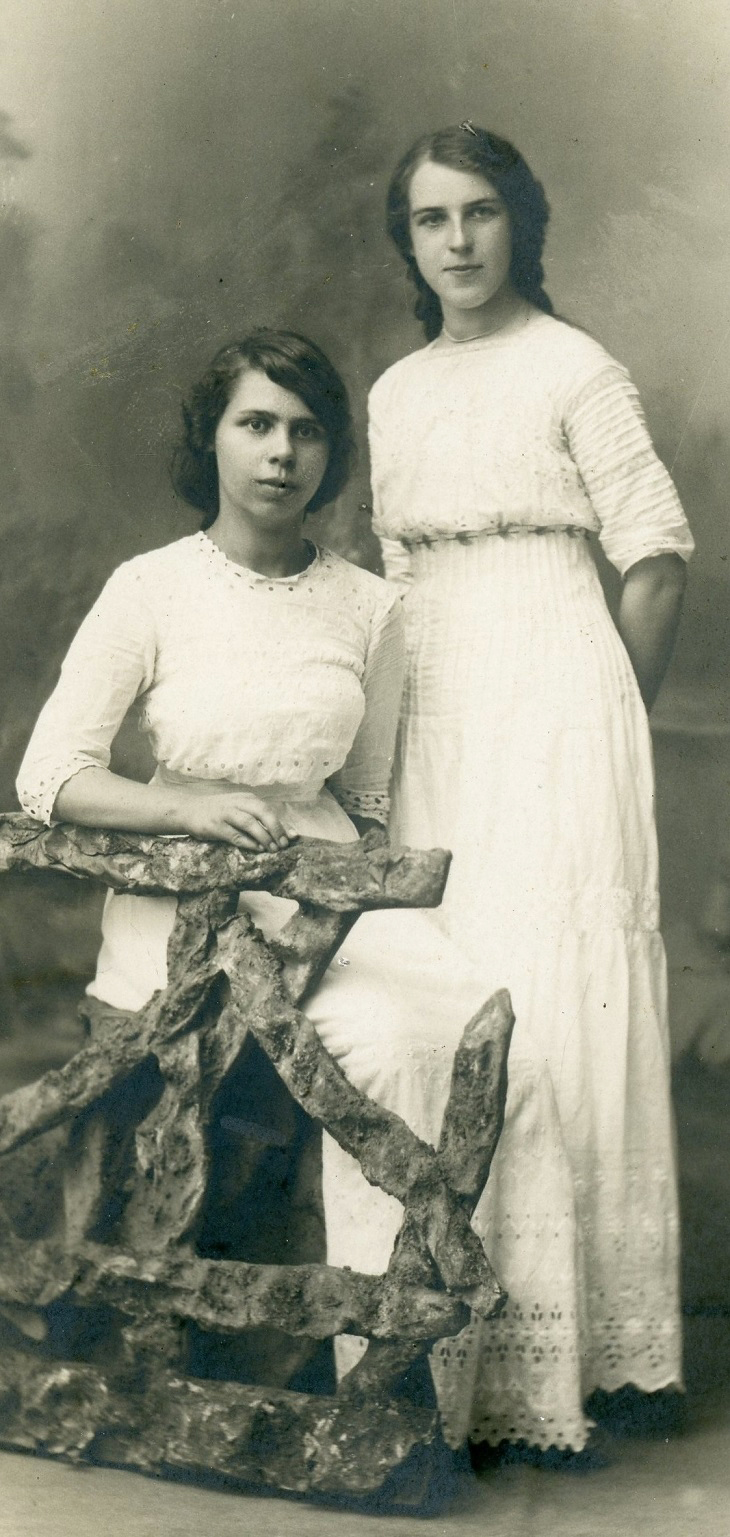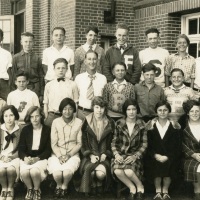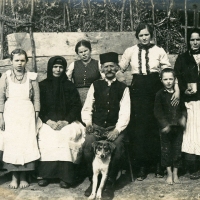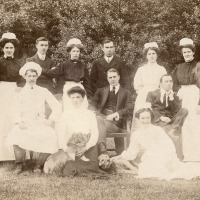This portrait of two friends was probably made in late imperial Russia (1910-1917). The only thing written on the back is a pair of names, which look to me like Tyosha and Marusya (Tеща и Маруся). I’m not sure about the name Tyosha, as I haven’t encountered it before:

The girls are both dressed entirely in white. Was that for school graduation? They look to be in their late teens, maybe 16-18 years old. (I have a hard time guessing ages!)

The backdrop is skillfully painted yet understated, with a single birch tree suggesting the vast boreal forest which covers most of Russia to this day.







Yes, late teens! Lovely photo!
LikeLiked by 3 people
Thank you, Shayne!
LikeLiked by 1 person
Enigmatic. One Giaconda smile, one furrowed brow. Leaves me, as these images always do, wondering who they were.
LikeLiked by 2 people
Yes, I noticed the difference in their expressions as well.
LikeLiked by 1 person
A direct look at the camera suggests confidence, while a downward look could indicate shyness or nervousness. Makes you wonder! 🙂
LikeLike
The dresses are very delicate and pretty – must have been a special occasion. 🙂
LikeLiked by 2 people
Yes, it must have been. Their dresses are gorgeous.
LikeLiked by 1 person
It has a very gentle peaceful feeling to it. I can imagine the two exchanging confidences upon walking home. Their dresses are beautifully crafted. All of those tiny pin tucks in the eyelet cloth, goodness what care would have been given to such a beauty as these. 😊🌷
LikeLiked by 2 people
See, I don’t even have the vocabulary to talk about such things. I’m going to have to google “pin tucks” and “eyelet cloth.” 😉
LikeLiked by 1 person
Wonderful photograph! And I like the gate which apparently has been made to look “rustic”
LikeLiked by 2 people
I wasn’t quite sure what to make of the gate. It looked liked something that had been dredged up from the bottom of the ocean.
LikeLiked by 2 people
Too funny, Liz! It really does!
LikeLiked by 1 person
😀
LikeLiked by 1 person
Yes, studio photographers could be very creative with props! 😀
LikeLike
Graduation would be my guess as well. A very innocent, peaceful photo taken before the chaos of the revolution.
LikeLiked by 2 people
It feels like we’re looking back at an idyllic time, a time when everything was beautiful and peaceful. Maybe even a pre-industrial time. Of course it’s an illusion, but it’s a lovely one.
LikeLiked by 1 person
Beautiful two young ladies!
Теща means mother-in-law. I wonder which of them mother-in-law?)
LikeLiked by 2 people
It’s a bit strange, isn’t it? Could it be an old name which isn’t used anymore? Or maybe Belorussian or another ethnicity?
LikeLike
I asked my mother for help 😊. Here’s what she said:
This is most likely a family photo. The white dress were worn on a special occasion. Women of the same age are photographed at the same level. So a lady who sits must be older than another lady.
On the back it is теща, which is rather strange. So it could be written not correctly (the trace is a letter without dots at the top), or the mother-in-law is a woman who sits. Clothing and hairstyles say it is around 1920.
A big hello from Moscow!
LikeLiked by 1 person
That’s very kind of her! Please thank her for me and say a big hello to Moscow from Vermont. 😉
LikeLike
Thank you, Brad!
It is a big pleasure to help you!
I think they are sisters. They have the same dresses. They don’t have hats or headscarves on their heads, which means the photo is not related to religion or graduation )
LikeLiked by 1 person
So lovely. My grandfather was Russian.
LikeLiked by 2 people
I became interested in Russia when I was a teenager, younger than the girls in this photo. I studied the language for years and visited a few places in European Russia. The culture is complicated and fascinating.
LikeLiked by 1 person
What a wonderful keepsake this portrait would have been for the two young women as they grew older. (So much nicer than a selfie.)
LikeLiked by 4 people
Whenever I see a portrait of friends, I wonder if the photo captured a single moment or a lifelong friendship.
LikeLiked by 2 people
I think the same thing!
LikeLiked by 1 person
I agree they’re probably late teens. Could it be a religious ceremony? How on earth you could read and translate those scrawls on the back, I don’t know!
LikeLiked by 1 person
I wondered if the dresses might be connected to a church ceremony. Maybe someone familiar with Orthodox traditions will see the post and let us know.
I studied Russian for many years, and worked for a while as a translator, but handwriting is always tough!
LikeLiked by 1 person
Beautiful! Though, I would probably have left the “gate” out, had I taken the photo 😁
LikeLiked by 1 person
The gate would make more sense if the girls were dressed for a walk in the country or something. 😉
LikeLiked by 1 person
Yes, totally! Now, it just looks a bit awkward. If, at least, it didn’t look quite so heavy. A fence made of slender birch tree branches could have been better;)
LikeLiked by 1 person
I like your idea! Although, in this case, the awkwardness is rather charming in itself.
LikeLike
I think the rustic gate is meant to heighten the charm of the photographed persons through contrast
LikeLiked by 2 people
Yes, maybe you’re right. It’s also a handy place to rest an arm when you’re sitting for photos.
LikeLiked by 1 person
They certainly look charming, though they could also just stand there without props and look just as great 😉
LikeLiked by 2 people
Poignantly reminiscent of the famous photographs of the last Tsar’s doomed daughters, dressed in white, virgin sacrifices to politics and war. I’m not trying to defend Imperial Russia through sentimentalization, just gratefully acknowledging the historical value of these extraordinary images of “ordinary” people that you share.
LikeLiked by 1 person
I hadn’t thought of the Tsar’s daughters, but I do remember photos of the family where all the daughters are wearing white. Thank you so much for your kind words, Pippa!
LikeLike
You truly have the most interesting website. Not only are the photos beautiful and fun to analyze, your readers make such insightful comments and observations. This post is a prime example. 🙂
LikeLiked by 1 person
It’s fun to select or “curate” photos to share. You must feel that way when choosing a film to review. Receiving thoughtful comments–like yours and the others above–is also really fun and encouraging. Let me take this opportunity to say again: I love the new look of your site. It’s super classy!
LikeLiked by 1 person
I know almost nothing about this period in Russian history, so I’m not going to be of any help there, but I do recognize out-of-this-world needlework when I see it, and the pintucks and lace are fabulous. Whatever their relationship, or background, they’re lovely girls. It took me a minute to sort it out, but the bottoms of the skirts on both their dresses are the same lace. Was Mom sewing for her two girls, or were the dresses made to meet some sort of requirement? I don’t have a clue.
LikeLiked by 1 person
Good observation, Linda. I thought the dresses had the same lace pattern, but didn’t trust my eyes enough to be sure. I don’t think the girls look enough alike to be sisters. Two friends might decide to wear dresses made from the same fabric, even if they weren’t obliged to. Sisters would probably only do it under duress! 😉
LikeLike
What a beautiful photograph!
LikeLiked by 1 person
Thank you, Tracey!
LikeLike
It’s a lovely photo, the dresses look very summery. By the way, my mother and her sister are about 18 months apart, and they often wore the same clothes when they were little. Although probably no longer when they were 18!
LikeLiked by 1 person
I have originated two versions about this photos : 1) “Tenza and Marusya”; 2) ” mother-in-Law and Marusya»
1) Initially, this the writing I have read as “Tenza and Marusya”, but drove away this thought. So as not very deeply analyzed this a picture of an. Tenza — the ancient Romans, chariot, artistically jeweled serving to transport the images of the gods during festive processions. This chariot was driven by white horses, oxen, mules, elephants, and the people themselves. In Imperial times, if the Senate awarded someone a tenza, it meant that the person is ranked among the host of gods.
Girls, their appearance, educated and likely to have studied or are studying at gymnasium. Accordingly, they studied the history of the Ancient world. If use this information and include imagination, then worthwhile active girl and there is Marusya, and sitting alluring dependent girl together with fence, (as this egoistically not sounds) she has called-Tenza. The inscription is most likely made by Marusya. Unconsciously she has is obtained so: I, Marusya – “the first, Empress, goddess.” ‘m standing in chariot, the second after me and adorning me, my girlfriend-simply” Tenza.”
2) Teenagers like to give nicknames to each other. Mother-in-law is the wife’s mother, and is often represent with a brawling woman (in Russia). Mary, Claudia, Ivan, Alyosha, the so – jokingly referred to as too simple and naive people. In this case, “Marusya” is a girl who sits,” mother-in-law ” is a girl who stands.
3) Option with kinship relations disappears, so as this physiologically impossible, because girls roughly one age.
I intuitively lean towards the first option. Girls educated, in gymnasium they must were develop creative imagination + youthful ambition (perhaps overstated) . Also confuses the curl at the Russian letter “Щ”, it seems to me, it is too big. This curl is closer to the Russian letter “З”. But this is my opinion, it is quite possible that I am mistaken.)))
Brad, thank you for what you’re doing! It’s great! I am truly grateful to you!
Best wishes, Elena.
LikeLiked by 1 person
Your first theory is very interesting, Elena! I’m not familiar with the word “tenza” but I think I understand it from the way you describe it. The gate with the seat behind it looks like a funny sort of chariot. At least, that could be a joke between the girls.
A slightly different interpretation would be that Marusya is the one who is seated. Her friend, who is standing, might have written “Tenza and Marusya” because Marusya is driving the chariot.
Thank you for sharing your very original interpretation! I like it! Cheers, Brad
LikeLike
Très belle photo où l’époque était aux portraits uniquement réservés aux grandes occasions . Ces images noir/blanc ou sépia étaient de belle qualité et restaient intactes très longtemps … Il y a 30 ou 40 ans , certaines photos traitées par l’industrie viraient au rose ou rouge . Que deviendront dans l’avenir les images numériques ?
Bon week-end .
LikeLiked by 1 person
Bonjour Pierrette! It seems that despite all of our amazing modern technologies, not much is likely to be preserved. Or rather, if we want it to be saved, we have to make a special effort to print photos onto paper or transfer files from an old storage medium to a new one (for example, from an old computer to a backup drive or to a new computer). How much will remain in 50 or 100 years? Some printed photos, maybe. If we’re lucky, some digital files which can be viewed on a future machine (like old negatives on a scanner today).
Bon samedi et merci pour le message!
LikeLike
Old classic, what a beauty
LikeLiked by 1 person